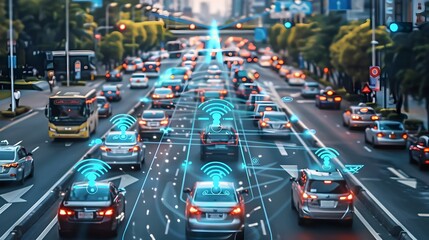In today’s urban landscape, congestion, pollution, and inefficiencies are significant challenges. Smart cities aim to address these problems through advanced technologies, and V2X (Vehicle-to-Everything) communication is playing a pivotal role in this transformation. V2X integrates vehicles with city infrastructure, ensuring real-time communication and improved coordination, which leads to safer, more efficient, and sustainable urban environments.
Integration with Urban Infrastructure
Traffic Management
Traffic congestion is one of the most pressing issues in cities worldwide. V2X-enabled systems use data from vehicles to optimize traffic flow:
- Adaptive Traffic Signals: These signals adjust their timing based on real-time traffic conditions, reducing idle times and helping commuters reach their destinations faster.
- Incident Detection: V2X can identify accidents or road obstructions and reroute traffic accordingly, minimizing delays.
- Dynamic Lane Management: Using V2X, highways can designate lanes for high-occupancy vehicles or public transport during peak hours.
Public Transport Efficiency
Cities are increasingly prioritizing public transport to reduce private vehicle dependency. V2X enhances the efficiency of buses, trams, and trains by:
- Real-Time Communication: Passengers receive live updates on arrival times, delays, and seat availability.
- Intersection Priority: Traffic lights can be programmed to prioritize public buses, reducing delays and ensuring schedule adherence.
Emergency Services
Emergency vehicles face delays in densely populated areas, costing precious time during critical situations. V2X facilitates:
- Clear Pathways: Vehicles on the road are alerted in advance to give way to ambulances or fire trucks.
- Coordinated Responses: Traffic lights turn green along the emergency vehicle’s route, ensuring unobstructed passage.
Sustainability and Emissions
Reduced Emissions
Congestion leads to increased fuel consumption and carbon emissions. V2X tackles these issues by:
- Eco-Friendly Routing: Vehicles are guided to less congested routes, saving fuel and time.
- Reduced Idling: Dynamic signal adjustments decrease the time vehicles spend idling at intersections, cutting emissions.
Integration with Electric Vehicles (EVs)
As EV adoption grows, V2X is instrumental in:
- Directing vehicles to the nearest available charging stations.
- Monitoring charging station usage and optimizing energy distribution during peak hours.
Real-World Examples of V2X in Smart Cities

Singapore: Leading the Way in Smart Mobility
Singapore integrates V2X with its Intelligent Transport System (ITS), using data from vehicles and infrastructure to:
- Manage peak-hour congestion.
- Implement real-time traffic updates for commuters.
- Enhance safety through connected vehicle systems.
Barcelona: Prioritizing Public and Emergency Transport
Barcelona’s smart city initiative employs V2X for:
- Coordinating traffic signals to prioritize buses and trams.
- Creating clear pathways for emergency vehicles during critical times.
Tampa, Florida: Connected Vehicle Pilot
Tampa’s pilot program equips vehicles and intersections with V2X to test its impact on safety and efficiency. Results showed reduced collisions and improved traffic flow.
Future Potential of V2X in Smart Cities
As urban populations grow, the need for efficient mobility solutions becomes more urgent. V2X will integrate further with other smart city technologies like IoT, AI, and renewable energy systems, creating a holistic urban ecosystem.
Potential advancements include:
- Autonomous Public Transport: V2X will be key to developing fully autonomous buses and shuttles.
- Pedestrian Safety Systems: Cameras and sensors will use V2X to warn drivers about unseen pedestrians or cyclists.
- Data-Driven Urban Planning: Cities can analyze V2X data to identify bottlenecks and plan infrastructure upgrades.
V2X technology is revolutionizing the way cities function, making them safer, greener, and more efficient. By integrating vehicles, infrastructure, and urban planning, V2X lays the groundwork for sustainable smart cities that cater to the needs of residents and commuters alike. The cities that embrace this technology today will lead the way toward a smarter and more connected tomorrow.
